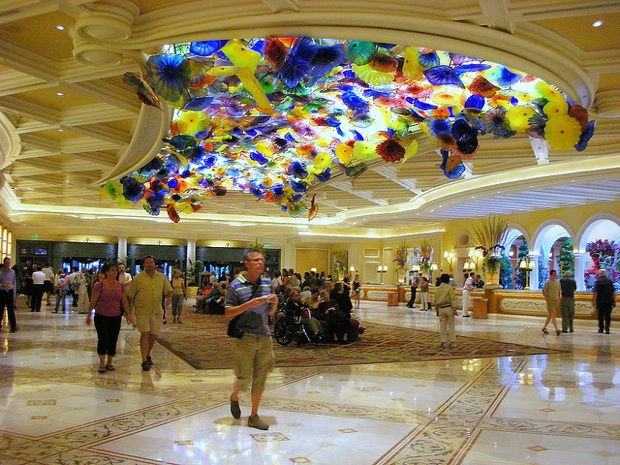How disruptive design made Wynn Resorts' casinos highly profitable

Design snobs are unlikely to look to Las Vegas for inspiration. But a recently published New Yorker profile of Roger Thomas, head of design at Wynn Resorts is an unexpected tale of disruptive innovation via design strategy. And, may I add, it's a tale of financially successful disruptive design. So even if Las Vegas doesn't reflect your personal tastes, this story--by the suddenly ubiquitous and very smart Jonah Lehrer--offers some valuable business lessons. (Note that a subscription is required to read the entire story online; it was published in the March 26 print issue.)
"Doing the opposite of what is usual has become Thomas's trademark," wrote Lehrer. "Beginning with the Bellagio Hotel, fourteen years ago, he has reinvented the look of the modern gambling hall by deliberately violating every previously accepted rule of casino design.
"In a world of corporate hotels slouching toward similarity," Lehrer continues, "Thomas's designs flaunt their uniqueness and, if anything, are getting quirkier from year to year."
For example, consider the recently redesigned high-limit slot-machine room at the Wynn Las Vegas. Intended for wealthy gamblers--assumed to be men seeking a masculine, clubby atmosphere--the previous incarnation of the room wasn't as profitable as expected. Data showed that women like to play slot machines more than men. So Thomas completely remade the room, and the result is unlike any other casino atmosphere.
It now has an entire wall of windows, flooding it with sunlight--unlike typical cave-like gambling rooms. It is filled with flowers and plants. There's white leather furniture--not chairs and couches covered with the usual spill-concealing upholstery. And decorations include tasteful antique lotus flower sculptures--far from fake Roman statues or other ersatz details one might expect in Vegas. All of these feminine details are intended to make women comfortable in the room--and, of course, spend money gambling there.
"People tend to take on the characteristics of a room," Thomas said to Lehrer. "They feel glamorous in a glamorous space, and rich in a rich space."
Thomas's risky, counter-intuitive approach has paid off in the past. The Bellagio, for instance, defied the principles of casino design that were in place for decades. Thomas designed the Bellagio to be easy to get around, and an elegant lobby without slot machines--the very opposite of what was proven to bring in revenues. He brought in antique clocks and skylights, defying the dominant paradigm of profitable casinos in the past: no indications of time, so gamblers would lose track of it and spend more money. Essentially, the disruptive design he (and Wynn Resorts owner Steve Wynn) put in place "represented a $1.6 billion bet on human psychology," as Lehrer wrote.

Today, the Bellagio holds the current record for generating the biggest profits for a single property in Las Vegas history. Per room, the Bellagio generates four times the money than the average in Vegas. Research by Karen Finlay, a professor at the University of Guelph, in Ontario, Canada, analyzed videos shot at various Vegas casinos to figure out why. The reason? "The data is clear. Gamblers in a playground casino will stay longer, feel better, and play more." She defines playground casinos--like those designed by Thomas--as providing a pleasant, pleasure-seeking atmosphere.
Thomas and Wynn have replicated their design strategy in China. The Wynn Macau, for instance, made a profit of more than $750 million in 2011.
So what are Thomas's methods?
- He doesn't use focus groups. Similar to the late Steve Jobs of Apple, he follows his personal taste
- He always carries a paper notebook, and sketches inspiring sights seen during his days--but he waits to sketch them from memory, not while he is looking at them
- He looks through dozens of his notebooks for inspiration before he begins to design
- He pays attention to design history, dating back centuries, and does not pay attention only to what's current and trendy
- He works with the Operations Department of Wynn Resorts, which meticulously manages details such as the consumption of alcohol and revenue of gambling machines and tables at each casino and hotel, to determine what needs to be re-designed--based on data
- He tests designs for effectiveness before building them; he even created a $2 million, life-sized model of the main gambling space at the Wynn Las Vegas to see if disruptive ideas like hanging a chandelier above a card table would work (in the past, no one did this, because chandeliers block security cameras)
Anyone interested in disruptive innovation could adapt Thomas's approach to disruptive design. He mixes personal inspiration with precise data analysis and prototyping. Ultimately, he uses a very deliberate process to break with what's worked in the past, to define what will work in the present and future.
Photos: Barbara Kraft, Wynn Resorts; Judy Baxter/Flickr
[Via The New Yorker]
This post was originally published on Smartplanet.com
